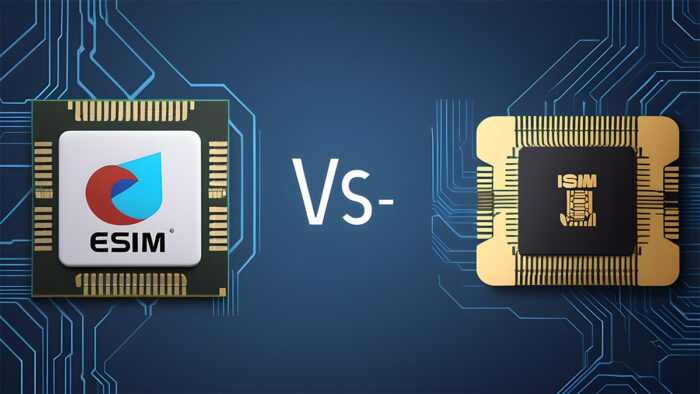In the world of SIM cards, two distinct players emerge: iSIM and eSIM. They might seem similar with the acronyms, but they represent different technologies. iSIM, short for “Integrated SIM,” and eSIM, or “Embedded SIM,” both aim to transform how devices connect to mobile networks.

But what exactly sets them apart? Let’s dive in and uncover the key differences between iSIM and eSIM in a way that’s easy to grasp for everyone. In this article, we will explore their differences and functionalities to uncover which one best suits your needs.
What is eSIM?
eSIM, or embedded SIM, was initially made to overcome the struggles that come with traditional SIM cards. The term “eSIM” stands for embedded SIM, or embedded Universal Integrated Circuit Card.
Unlike traditional SIM cards that you insert into your device, this one is permanently installed within the device itself. To use it, you need a device compatible with this technology and a carrier that supports it.
Instead of physically inserting a plastic card, it enables you to download a carrier profile directly to your device over the air. Carriers usually provide an authentication code or QR code for digital activation of your eSIM.
With eSIM, you can download multiple carrier profiles onto a device and easily switch between them.
This flexibility makes eSIM easier than traditional SIM cards, particularly for international travel. You can just download an eSIM profile before reaching your destination.
Wearable devices like the Samsung Gear S2 and Apple Watch were among the first devices to adopt the SIM in 2016. And it has since expanded to include tablets and laptops.
What is iSIM?
iSIM, short for integrated SIM, is a very new technology that combines the functionalities of traditional SIM cards into the device’s hardware itself. Unlike regular SIM cards, which are physical cards that need to be put into a device physically,.
This technology is built directly into the device’s chipset or processor. This integration removes the need for a separate physical SIM card slot. And offers more flexibility and space-saving benefits in design.
This technology allows remote provisioning and management of SIM profiles. It enables users to switch between various mobile network operators and plans without needing to physically replace a SIM card.
It is very useful for smaller and more compact devices, such as wearables and connected gadgets, where space is limited. Although it is the most secure solution so far, no portable device or smartphone has adopted the technology yet.
iSIM vs. eSIM: benefits
iSIM
Compared to the regular SIM card, below are the three iSIM technologies:
- With this technology, you don’t need a card slot or SIM reader on your device, thereby saving space.
- It offers the most safe SIM implementation, thereby preventing hackers from tampering with or accessing it.
- It offers the most safe SIM implementation, thereby preventing hackers from tampering with or accessing it.
- Since it is programmable, you can easily switch between plans and carriers as you wish.
The setback is that, at the moment, you can’t purchase a device with it. Also, moving between the devices may be difficult, so you may have to contact your carrier.
eSIM
- It is very easy to switch between various carriers, numbers, or plans with just a few taps.
- The supported smartphone can accept other hardware, like a larger battery.
- It is more secure, and hackers cannot bypass your device lock screen to copy or access the carrier profile.
However, the drawback is that only a limited number of devices support this technology today. And you won’t be able to enjoy its available benefits on mid-range Android phones.
What’s the Difference Between iSIM and eSIM?
iSIM is embedded directly into a device’s chipset, offering tighter integration and potentially lower costs, while eSIM is a removable chip soldered onto a device’s circuit board, providing flexibility for swapping carriers without physical SIM cards.
They both ditch the physical SIM card, but they make use of slightly different methods to get the work done. Imagine eSIM as the middle ground between two options. It gives you most of the benefits, like activating a plan wirelessly and changing profiles in software. Plus, it helps to save the most space, thereby giving room for a bigger battery or extra sensors on very small gadgets.
Size and power
iSIMs were made to meet the demand for very small, affordable, and more secure SIM cards. And they deliver just that. By being built into the cellular module, they’re 98% smaller than eSIMs. This not only makes them much cheaper to produce,.
They cost 50% less due to their very simple designs and fewer parts, but they also save on space. Additionally, they consume up to 70% less power, potentially extending the battery life of the phone.
Which Smartphones support eSIM and iSIM?
Just like I have mentioned above, the eSim is becoming commonplace on high-end and mid-range smartphones. You can also find the technology on some tablets and wearable devices. Some of the devices that support it include:
- All the mainline iPhones since the Xs product, the iPhone SE 2nd generation and the newer, and cellular Apple Smartwatch lineups.
- The entire Motorola Razr model and Edge 2022.
- Samsung: All Galaxy S series since the S20, all the Fold and Z Flip models
- All Google Pixel phones going back to Pixel 2 and all Pixel Smartwatch models.
Some smartphones from manufacturers like Xiaomi, Nokia, Sony, and OPPO also support this technology. So you can check your phone to see if it is compatible with the technology.
As for the smartphones that support iSIM, the list is empty at the moment. Manufacturers and chip makers are yet to embrace it. However, the good news is that all the support that went into eSim on the carrier side and the software can also be used for this technology. We just really don’t know when it will start.
Which One is More Secure?
While regular SIM cards have always raised security concerns due to their susceptibility to tampering, eSIM and iSIM cards offer very high security by being inaccessible physically.
However, there are some security concerns about iSIM technology as it’s still new and hasn’t gotten existing SIM certifications. Nevertheless, it’s expected that iSIM technology will likely undergo accreditation in the near future, alleviating these concerns.



